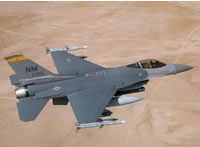
To keep the F-16 family of fighters running at top performance, operating air forces worldwide are implementing various upgrading programs. The Common Configuration Implementation Program (CCIP) provides a high degree of commonality in hardware and software, thus improving operational flexibility, logistics support and reducing life cycle costs, training. After receiving the F-16 CCIP upgrade, and the M3/3+ software enhancement, USAF Block 40/42s and 50/52s and NATO’s F-16s will have common core avionics and software. With the recent software upgrade, these aircraft will have the capability to deploy support smart weapons with inertial, GPS and laser guidance systems, supporting advanced weapons such as the GBU-31 Joint Direct Attack Munition (JDAM), AGM-154 Joint Stand-Off Weapon (JSOW), CBU-103/104/105 Wind-Corrected Munitions Dispenser (WCMD) and EGBU-27 enhanced laser-guided bomb.
Up to 650 Block 40/42 aircraft of the USAF and US Air National Guard are being upgraded under this program. The upgrades also provide a high degree of commonality and convergence of existing fleets with new production F-16s built for international customers, and with the F-16 Mid-Life Update being performed on 400 F-16A/Bs operated by five European NATO partners. The program is divided into phases: Phase I and IA for the initial systems to Block 50/52 aircraft; Phase II for the full modification to Block 50/52 aircraft; and Phase III for the full modification to Block 40/42 aircraft.
European MLU Upgrades
Another upgrade is the F-16A/B Mid-Life Update (MLU) implemented in various phases by NATO air forces operating the F-16 – Belgium, Denmark, the Netherlands, Norway and Portugal. The latest MLU upgrade is focusing primarily in avionic modernization, and include Block 50 F-16C/D-style cockpit with color multifunction displays, modular mission computer, APG-66(V)2 radar update, integration of a digital terrain system, global positioning system (GPS), advanced identification friend or foe (IFF), improved data modem data link, installation of an electronic warfare management system, and provisions for a reconnaissance pod and a helmet-mounted display. A upgrade of the Portuguese Air Force F-16A/B aircraft included this MLU Phase II also included the Falcon UP/Falcon STAR structural upgrades, and F100-PW-220E engine upgrades. Further upgrades to the Portuguese aircraft included a night identification light, dedicated electronic warfare MUX bus, additional chaff/flare dispensers and provisions for an internal missile warning system and a flight analyzer/air combat evaluation/voice and data recorder.
Israeli F-16 Upgrades
Most of Israel’s F-16s have already undergone the Falcon-UP service life extension program, performed both by the IAF support center and IAI. Other modernizations included the installation of internal ACMI systems (in F-16As) associated with ground debriefing systems (similar but less sophisticated as the F-16I SIMNET). Also implemented are adaptations for Israeli weapons and systems, such as the EW systems, Python 4 missiles carrying capability, communications, data-links, etc. Another upgrade program called ACE program is proposed by a consortium of Israeli companies for early models Block 10 – 30 aircraft. ACE integrates a new multi-mission radar from Elta (EL/M-2032), improved core avionics, a modern color glass cockpit and helmet mounted sight, introduction of new weapons capabilities, advanced EW systems, fuel increase options and other avionic upgrades.
Preparing for Future Upgrades
With the recent acquisitions of F-16s, Lockheed Martin plans to sustain production on the F-16 line at Ft. Worth beyond 2010. Major upgrades for all F-16 versions are being incorporated to keep the fleet modern and fully supportable over the aircraft’s long service life. As all F-16 blocks, recent production blocks of the F-16 such as Block 50, 52 and 60 are also designed, from the ground up, with enough growth potential in weight growth, cabling, data connectivity and capacity, electrical power, and physical space, to enable growth throughout a life span of 40 years and beyond. Utilization of standard interfaces such as 1760, 1553 and the new FiberChannel five channels, Gigabit rate databus, enable rapid interfacing and data sharing throughout the aircraft systems. In addition to the production programs, Lockheed Martin has incorporated a “roadmap of convergence” for F-16 upgrades and production aircraft, consisting of an integrated plan that will result in maximum commonality throughout the fleet.
Additional Parts of this article :
- Advanced F-16 Block 50/52/60
- Modernization of the F-16 Fleet
- F-16 Software Upgrade



















